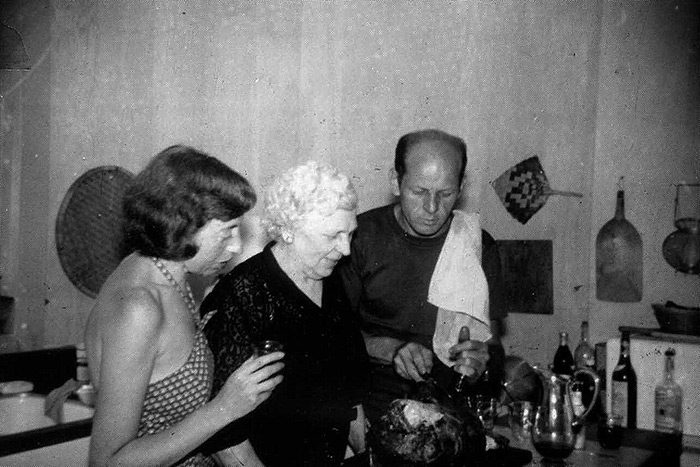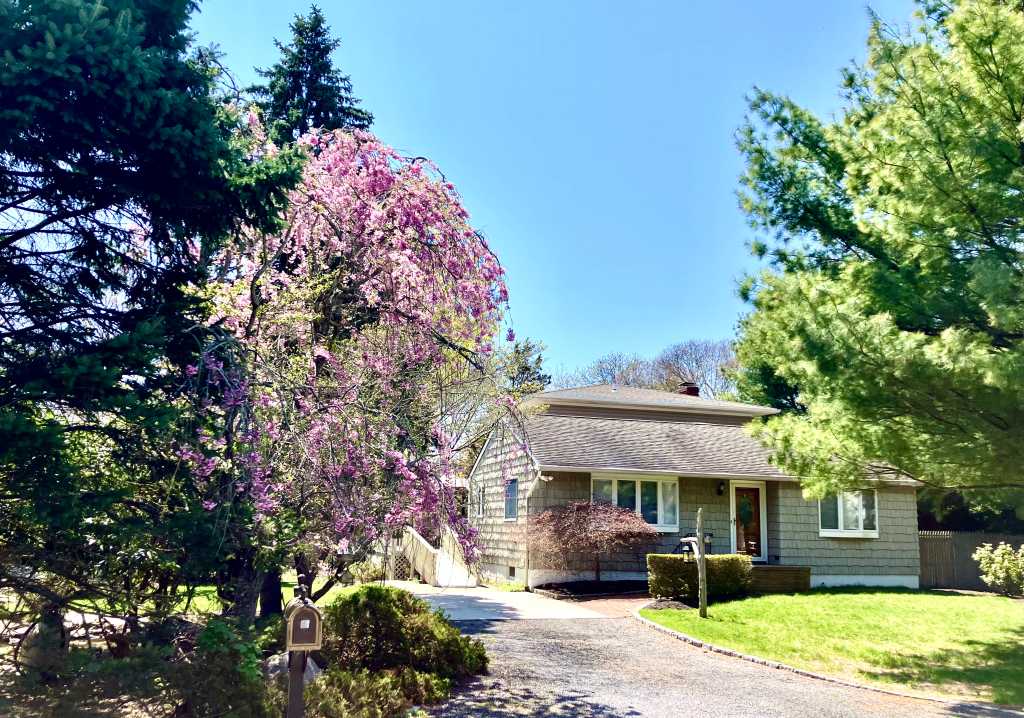Dinner with Jackson: Dozens Celebrate Pollock on His Birthday

A couple of weeks ago, I got an invitation to attend a birthday dinner given for Jackson Pollock here in Springs. It would be on Sunday, January 28, from 5 to 9, and it would not be at his house on Springs Fireplace Road, but at the Springs Tavern, which is right up the street from his house on Fort Pond Boulevard. Food served would be from a cookbook of Jackson’s favorite recipes.
I spoke to my wife about whether we should go or not. We are both four-star Michelin cooks in that publication’s little known “private” chef home edition—maybe you’ve heard of this—and our initial reaction was (well, at least her initial reaction) was yuck, we’ll just get a can of beans or something. Jackson was notoriously poor back in the day. He also drank a lot. He sometimes swapped paintings for food at the Miller General Store (now the Springs General Store) around the corner from his house when he was out of money. You’d see him on his bike.
But we decided to go.
I’d never met Jackson Pollock. He died in a car crash shortly before I started Dan’s Papers in Montauk in 1960. But I did write about him. He was the most famous painter on the planet. And he hung out at a run-down bar called Jungle Pete’s on Fort Pond Boulevard. After he died, I went there to talk to some of the locals about his time there.
I’ve never forgotten that day I did that. Here I was, 20 years old, parking my tail-finned Ford convertible next to all these pickup trucks at a joint named Jungle Pete’s. Inside were a bunch of shabbily dressed fishermen, half in the bag, sitting at the bar, talking loudly to one another in their almost unintelligible Bonac accent, and in comes this well-dressed Jewish kid wanting to know about Jackson.
“Go home, kid, we don’t know nothin’. He was a good guy. Sure we had to carry him home sometimes. Each of us gets carried home every once in a while. We don’t want you writin’ anything bad about him.”
One of them came out with me to where I parked my car. He wanted to know about the tailfins and did it have power steering, which it did. Then he went back inside.
Jungle Pete’s is now the Springs Tavern. It would be nice to go back.
Also, as I knew, a few years ago a writer from Australia named Robyn Lea was poking around at Jackson’s house, doing a story about this man whose paintings sell for tens of millions of dollars today—the house is now a museum and study space, open by invitation this time of year—and in the pantry Lea came upon lots of fancy pots and pans that you might only see at the home of what today we would call a foodie. Since the house has been restored to look exactly as it did when Pollock and his wife, Lee Krasner, lived there back in the day, including beds, sofas and furnishings, Lea kinda wondered what they ate.
Several well-worn cookbooks were in that pantry, and tucked into them here and there were recipes clipped out of newspapers from that time, as well as handwritten recipes from Jackson’s mother, from neighbors and friends, some recipes Lee wrote in her careful hand, and some that Jackson wrote in his big scrawl. Jackson was a terrific cook! Who knew! And he was a terrific gardener!
The Hamptons back then in the 1940s and 1950s was a cornucopia of good things to eat that you could grow, gather and get yourself. There were fish in the sea, clams in the bays, corn you could plant, strawberries, vegetables, potatoes, even local bottles of milk from nearby dairy cows. We still have lots of stuff like that today. And the Pollocks had a garden out back.
Earlier, in 1946, an art dealer in Manhattan thought Jackson Pollock was a genius. Her name was Peggy Guggenheim, and she made this deal with Jackson and Lee that they should move out from their ratty Manhattan apartment to this house she’d rent for them in East Hampton for a year or two, give them a monthly stipend, and, in exchange for that, Peggy would get all the paintings Jackson made during those two years.
The Pollocks loved it out here. Away from the New York City art scene, he produced his best work, not only in those two years but in the five years that followed before the car crash, not only in his studio behind the house but in the backyard leading down to Accabonac Harbor, where he brought out a stepladder, began playing music on his records real loud with the back door open, and developed his slashing, passionate drip paintings, dripping paint from his perch on the ladder to the canvas on the ground below.
The owner of the Miller Store, who was still the same owner who was there in the 1960s and when I bought groceries there in the 1980s, told me that the paintings Jackson had swapped for food had paid the way for all his children to go to college.
Last year, Robyn Lea’s cookbook, Dinner with Jackson Pollock, appeared. It’s a big, hardcover coffee table affair from Assouline. In it are 59 recipes that Lea found in the Pollock’s pantry, with the handwritten notes and newspaper clippings to prove it. There are also pictures of Jackson and Lee cooking. And pictures of Jackson painting.
There was an annual Fisherman’s Fair back then—we still have it every August—and one year Jackson’s entry won the apple pie contest. The recipe’s in the book. Also the recipe for Jackson’s Classic Rye Bread (he baked!), Jackson’s Famous Spaghetti Sauce, and the recipes brought over by Jackson and Lee’s friends when they came for dinner parties held at their big, round dining table that seated 10 (that’s still in the house, too).
These guests were painters and sculptors and critics who—with Jackson here, and the north light in Springs considered phenomenal for painting—moved out after the Pollocks did, to paint and sculpt and develop an artist colony here that, for several generations, was considered the center of the Abstract Expressionist art world. In Jackson’s pantry cookbooks, Lea found recipes for Elaine de Kooning’s Fruit and Grain Salad, Perle Fine’s Bouillabaisse, Rita Benton’s Pecan Torte with Mocha Frosting, and on and on.
So here is what we ate on January 28 at the former Jungle Pete’s at our appointed dinner reservation at 6:30 p.m.
FIRST COURSE
CHOICE OF
Creamy Onion Soup with Cross-Country Johnny Cakes
Wild Forest Greens with Anchovy French Dressing
SECOND COURSE
CHOICE OF
French Style Roast Chicken – Herb Stuffing Pan Gravy, Roasted Root Vegetables, Walnut and Maple Dressing and Stella’s Pancakes
Jackson’s Famous Spaghetti Sauce Served with Pasta
Classic Meatloaf served with Mustard Sauce, Green Salad
DESSERT
CHOICE OF
Brandy Peaches w. Soft Custard
Raspberry Poached Pears w. Bavarian Cream
The place was packed with celebrants. Usually the five TV screens that line the walls of the dining room and bar here are tuned to basketball, hockey, tennis and golf. On this day, the ones in the dining area were a slide show of Krasner’s paintings, Pollock’s paintings, the two cooking together, Pollock drip-painting in the yard, Krasner and Pollock in their dining room. They were there. We were here. We sang “Happy birthday, dear Jackson.” And the food was wonderful, particularly Jackson’s special spaghetti sauce. I am not kidding. What they ate then was as good as what we eat cooking at home or eating in restaurants now. And Helen Harrison, the director of the Pollock-Krasner House, said maybe this would be the first of many birthday parties at the Springs Tavern this year.
“Bill de Kooning’s birthday is in April,” she said. “I’d go.”
Happy Birthday, Jackson. We drink to you. Local wine.



